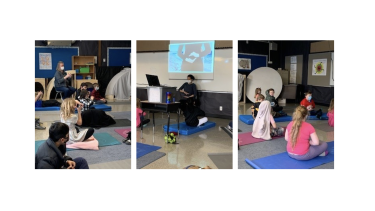
THE OT/SEL BUZZ
SEL Inside Out Project in Schools: Self-Regulation Skills for All!
This year, Ross, Ten Broeck elementary and Chief Dan Middle school partnered with our district occupational therapist to re-imagine their practices to address self-regulation needs. This project is called SEL Inside Out and it involves addressing self-regulation skills at the whole school, classroom, and individual student level.
School wide interventions, the journey begins with connecting as staff, learning together to determine our own self-regulation needs and preferences. As the staff continue to learn about themselves, they have been able to learn to apply this knowledge to their students. Classroom observations also take place to design environments for learning from a sensory aware and trauma informed lens. Students, teachers have an opportunity to share their voices and design their environments. Together with the occupational therapist (OT), classrooms assess the environment and design classroom wide self-reg interventions using the eight senses as a foundation (sense of vision, hearing, taste, touch, smell, proprioception, vestibular and interoception). Participating classrooms receive an eight session self-regulation education program where students learn about their senses, body sensations and how all of these affect our emotions, mental health, and function. Dynamic seating and other sensory interventions are implemented in each classroom that participates in the project.
Research shows us that children’s brains and bodies develop in accordance with the different types of stimulation found in their surrounding environment. The way our brains process sensory information impacts all areas of development in children and adults. It is critical that all school staff understand and are aware of the impact of the senses on mental health and overall school performance and participation. Sensory processing challenges occur when the nervous system does not efficiently register, orient to, modulate, or integrate sensory input. Therefore thought, and intention is placed on how micro-environments are designed and their locations in classrooms. All classrooms are encouraged to have a calm/peace corner and a movement corner. From research and experience we know that it is very important to understand sensory processing when working with children. When students struggle with hypervigilant or hypovigilant behaviors, we see dysregulated states of arousal. Students can show sensitivity to touch, sounds, movement, and smells which can contribute to flight, fight, or freeze reactions (van der Kolk, 2005). Our goal is that schools and classroom do not become environments that activate stress responses. Knowledge about the use of sensory motor input to calm the nervous system is critical for trauma informed schools. This knowledge is taught to staff so they can use it to offer self-regulation breaks and interventions throughout the day at school and in the classroom (Koomar et al, 2016, Ogden 2016).
SEL Inside out is a yearlong project and it involves school support staff, classroom teachers, students, and parents. Students with exceptional self-regulation and mental health needs receive a holistic and evidence-based approach to address their self-regulation and trauma healing needs. The outcomes reported are already changing student’s lives by equipping them to know more about their bodies and their self-regulation needs. Teachers are better prepared to provide and design environments from a sensory enhanced, trauma informed lens.
We hope that you join us in this journey!